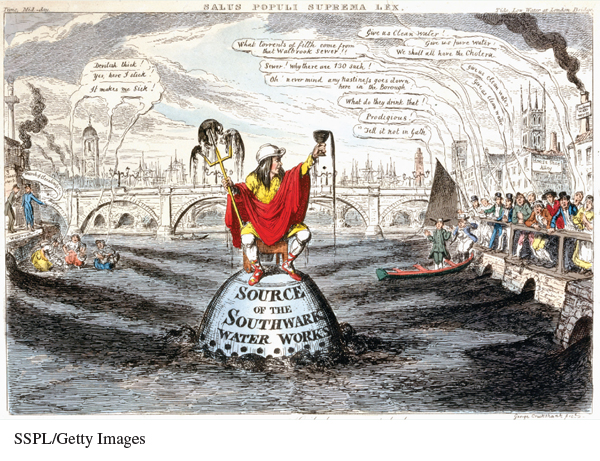A History of Western Society: Printed Page 724
The Past Living Now
Modern Sewage Systems
S ome of our most mundane activities, such as taking a shower or flushing the toilet, bring us into daily contact with an unappreciated marvel of late-
The rapid growth of cities and explosive rise in urban populations across the nineteenth century overwhelmed these methods of sewage disposal. In an ironic twist, the popularization of a sanitation improvement — the flush toilet — spelled disaster for the cesspool. With each flush, a large volume of water accompanied a small amount of waste, rapidly filling cesspools with liquid. Cesspool pits then leaked, spilling untreated sewage into waterways. The results — unbearably odorous — were also deadly. Water polluted with the bacteria that cause cholera and typhoid seeped into drinking supplies, causing mass epidemics across Europe.
London, the largest city in the world at the time, was a perfect example. As the population more than tripled from about 1.3 million in 1825 to 4.2 million in 1875, the sewage problem became catastrophic. Cesspools overflowed, and flush toilets installed in new buildings drained directly into the River Thames, the main source of drinking water for London residents. Over twenty thousand died in the cholera epidemics of 1832 and 1849, and another eleven thousand perished of the same disease in 1854. Though urban reformers initially blamed the epidemics on foul smells (or “miasmas”) rather than bacteria, they did correctly identify putrid water as the cause and called on urban authorities to take action. The famous “Great Stink” of the summer of 1858, when appalling fumes from the fetid river threatened to shut down the city, underscored the urgent need for change.

In response, between 1858 and 1865 the London Metropolitan Board of Works, led by engineer Joseph Bazalgette, built a massive network of new sewers that one Sunday paper called “the most extensive and wonderful work of modern times.”* Bazalgette and his construction crews enclosed open canals in underground channels that combined flows of rainwater and human waste. London’s massive interception sewers now emptied sewage into irrigation fields and treatment plants rather than directly into the Thames.
Inspired by London’s example, urban engineers across Europe and North America built their own sewers and treatment plants, which limited the dumping of raw waste into local rivers, lakes, or seas. Sewage systems have improved since then, but the basic nineteenth-
QUESTIONS FOR ANALYSIS
- Why would contemporaries view Bazalgette’s sewer system as a “wonderful work of modern times”?
- How did progressive ideas about public health and urban reform drive the construction of late-
nineteenth- century sewage systems? What other public works projects or public health initiatives promoted today have roots in nineteenth- century visions of social progress?